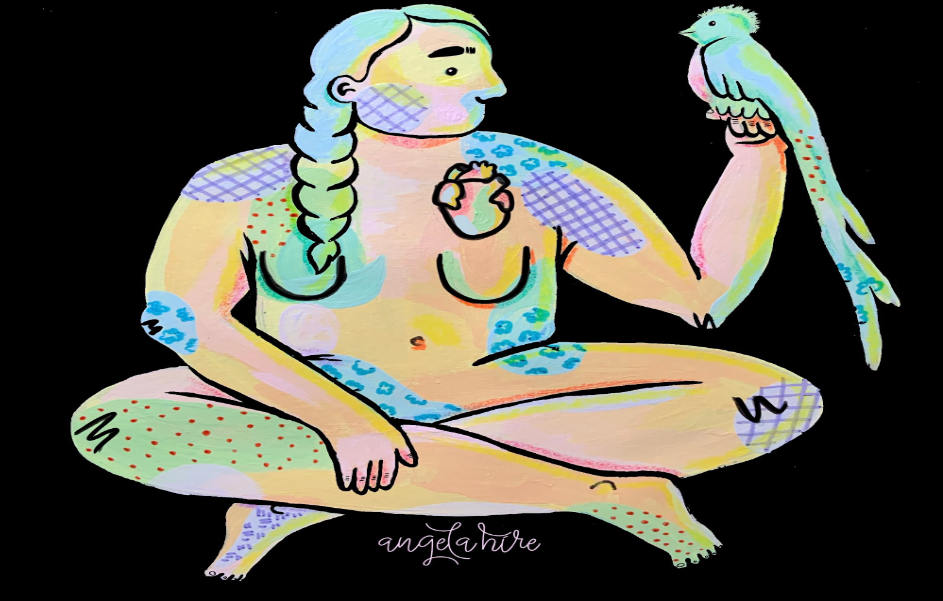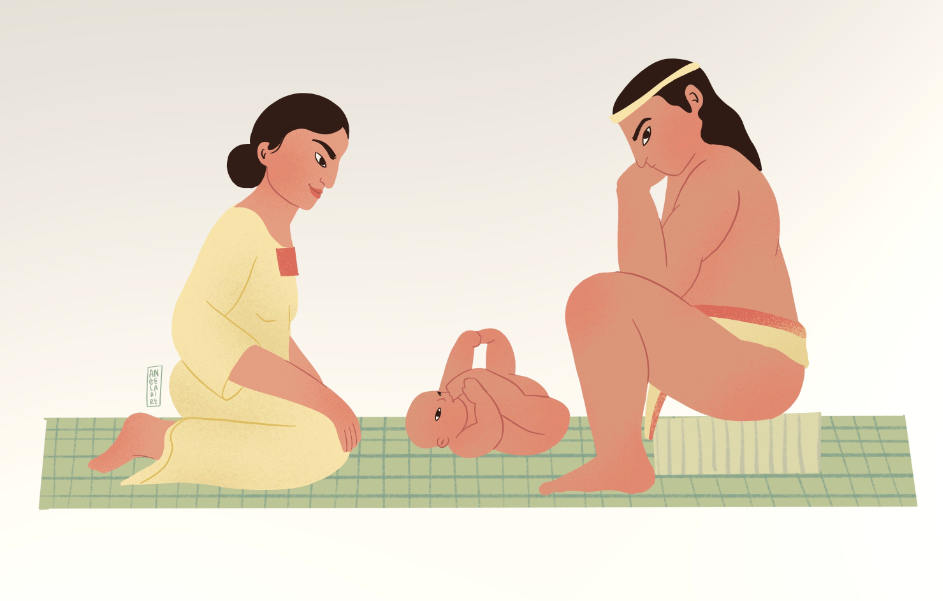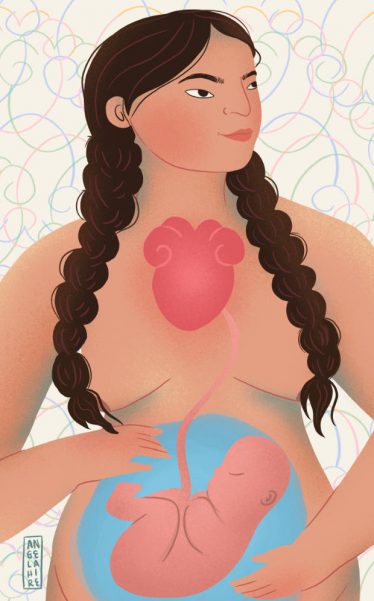Pregnancy in the Mesoamerican world is a process that goes beyond the activity of procreation; it is a feminine and community phenomenon, loaded with rituals, discourses, and community meanings. Its stages are cared for by the pregnant woman’s family and the curandera. The woman is never alone in this process.

Mesoamerican procreation implied the social formation of marriage or concubinage and therefore of a socially accepted family. There were cared for and advised around getting pregnant, during childbirth, and at the end of it. The pregnant couple carried social and even divine responsibilities since conception was not only a social activity but also a divine design.
The process of pregnancy in the Nahua area of pre-Columbian Mesoamerica is complex because of its cultural, linguistic, ritual, and therefore social linkage. Giving birth, begetting, bringing a new being into the world, entailed a complex social and discursive warp that, by showing it and trying to unravel it, reveals how marvelous the social conception of such a natural, biological, and even daily act can be, as is the formation of a being in the womb of a woman.
What is pregnancy?
It is a facet, a light of the change in the stages of human life. On the one hand, we find the biological aspect, pregnancy as a natural and human reproductive process, and on the other hand the cultural aspect of pregnancy, where each culture fills this process with meaning and gives it different explanations.
Human reproduction is not merely a biological matter, but a social activity, which is determined by different conditions such as political, material, linguistic and socio-cultural. It establishes a model of care based on an ideology of reproduction that gives meaning to all its elements such as pregnancy, and its subsequent stages, childbirth, and puerperium. It developed certain notions about maternity and paternity. On the role of men and women in the community.

Let’s talk about the biological aspect of pregnancy. Doctors and anatomical scientists will be able to make a better descriptive analysis, but roughly speaking pregnancy is composed of three stages: pregnancy, labor, and puerperium. The biological phenomena within pregnancy are: cessation of menstrual periods, increase in belly and breast volume, darkening of nipples, the midline of the abdomen and regions of the face, and the perception of fetal movements.
The biological phenomena within labor are contractions of the uterus, mucus, and blood coming out of her genitals, the desire to push, amniotic fluid coming out, seeing how her “child” comes out and remains attached to her by the umbilical cord that must be cut after expelling the placenta. And finally, the biological phenomena in the puerperium that the newly delivered woman experiences are: abdominal pain, blood loss, and feeling how her breasts fill with the milk with which she will feed the newborn.
All these meanings are explained and dealt with through care, warnings, and mythologies that give us a guideline to talk about the cultural aspect of pregnancy.
Where do babies come from?
To answer this question we can only allude to the cultural aspect of the community we are living in or feel we belong to. Babies are brought by the stork, they are born from a cabbage, God sends them to earth, they are engendered by a male seed. Each culture provides a narrative. This is where explanations of the why of reality begin. Immersed in the language itself.
Let us go to the classic náhul, language by which cultural aspects of central Mesoamerica in pre-Columbian times were recovered or described, just when the Spaniards arrived in these lands and recorded it in what would later become Molina’s vocabulary. A vocabulary that comes from the Mexican people and Castillian Spanish, tells us that pregnancy in the Nahuatl language was said: netlacaualtiliztli which means pregnancy as such. But the word that has a meaning closer to what we are interested in is conception, the Nahua verbs that are related to conceive or impregnate are: motlalia which means “to settle”, itetia which means “to form womb”, itetinemi which means “to live in the womb”, ococox which means “to have become ill” and itlacahui which means “to have been damaged”.

For the ancient Nahua, being pregnant was a state focused on the woman’s womb, in her central body area. At that moment, life would lay and this state was an imbalance in the body itself and therefore its care, in which not only those who were going to become father and mother intervened but also the close relatives and the curandera, the medical and ritual specialist. Reading the sources we can realize that the Nahua thought that conception was a divine decision.
I want to highlight the fact that the sources are composed under the Catholic filter of the European Middle Ages and it is difficult for us to discern between the possible cultural parallels and the biased reports or influenced by the discursive encounters that took place at that time. But this does not invalidate the effort and the data that were collected and today we can consult to give a glimpse of the culture of the time. With this, we can realize reading the text that duality is the source of generation of life.
What was the role of women in pregnancy?
The woman was a fundamental part of Mesoamerican society since she was the primordial link between humans and divinity because she could beget and carry life, a channel of life, through which the deities designated existences, they could beget thanks to the grace of the divinities who had so decided.
The physiological processes of women, from growth to childbirth, are connoted in the Mesoamerican Nahua community, and therefore there are a series of rules and processes that must be carried out. The construction of the feminine in the Mesoamerican world is divided into three biological stages of the woman: childhood (piltontli), youth (ichpuchtli), and old age (cihuatlapalihui); the great turning point is when she begins to menstruate and this is the moment when her fertility begins, from woman to mother.
Women in the Mesoamerican world had to carry out several social roles, the primordial one being that of motherhood, and they constructed their femininity from this gestation process. The relevant aspect of Mesoamerican motherhood was its link with the social bases, its perpetuation.
Although the education of the ancient Nahua was indeed not only in the hands of their mothers but of a whole institution, it is important to highlight the fact that the first years, the years of learning the language and social values, were spent under the protection of the maternal home and at a certain age they left home to learn what would be their trade, their role within society.
The relationship of women with their environment is a source of divine designs, community acts, and part of the social gear. There are female goddesses in the Mesoamerican pantheon, there are concubines and there are mothers. They are part of the lineage and therefore have a political role. They are singers, they are weavers, they are healers and they usually appear seated. As if representing the base of the society they are part of.
What is pregnancy like in an indigenous Mexican community today?
There is no single answer, this experience is as diverse as each woman herself, as each of the more than 50 indigenous communities that exist in the Mexican country. Carrillo, a Nahua-speaking ethnologist, told me a little about her experience of giving birth in 2020, who although it is true that she resorted to traditional treatments had the opportunity to see her son being born in one of the few hospitals open in the area: “In the penultimate month, more or less around week 33, I went to a midwife to accommodate the baby, she told me that I was already in a position that I should take a bath in Temazcal, as it is customary here where I am in Tlaxcala. My son was born in week 37, he was about to be born in week 36.”
“And well, it is also customary for pregnant women to wear a red ribbon around the waist that does not show, that is, it should be wide and not hurt the baby, it is to protect the mother and child from envy, the evil eye and also from the evils that can cause lunar movements, sometimes that ribbon is placed with a small mirror and also some little locks, those that adjust the clothes. When there is an eclipse or full moon, one should not go out because the moonlight can hurt the child”.

The Temazcal, that herbal steam bath, is still a daily practice in Mexican indigenous communities, both for the woman before and after childbirth as well as for the babies, and as in the times of the pre-Columbian manuscripts, the midwives still accompany today’s mothers in this process. She also comments on the relevance of the moon and its movements in this process.
I will talk about the representations of the moon in different cultures in another text. For the moment I close this writing by sharing my amazement for this phenomenon so normal, every day, and at the same time so full of rituals, beliefs, and meanings. As we can see, women in Mesoamerican culture and nowadays have been and are social beings, bearers of cultural representations, and spread values with their daily actions. There is no better metaphor to describe this phenomenon, to give birth, and with their light, they are one more guide of the society in which we live.


